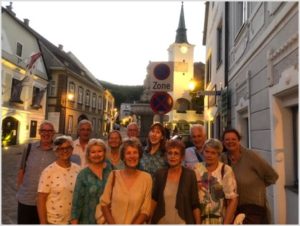DRESDEN, WEIMAR AND LEIPZIG: ALL THE MAHLER SYMPHONIES, 11-29 MAY 2023
FOLLOWING THE VIA FRANCIGENA, ITALY 18 APRIL – 3 MAY 2023
A Road Trip
A Road Trip
Early this year my book The Poinciana Tree was published by Connor Court. I called it a novel but in essence it was a memoir of my family in the middle of last century. While the characters and events were real, their conversations and experiences were imagined, but I made sure that their responses to circumstances should be authentic to their personalities.
Though the book’s time frame stretched back to long before I was born and forward to the first twenty odd years of my life, I loved the process of delving into my earliest memories, especially stories and events told to me as a young person by parents and their friends at the time. Sally thought there were too many characters in the book, but if you are recalling and writing about your distant memories, there were lots of people I encountered who influenced me.
Sally’s dear friend Cathy had been intrigued by my book and this November asked us to join her and her husband Lynn on a road trip through central west NSW and southern Queensland to visit places and surviving people featured in the Poinciana Tree. Just before we were due to go, to everyone’s dismay, they both came down with Covid, so after some soul-searching, we seized the moment and decided to go on our own.
We were away for a little over a week and it turned out to be an amazing experience, not just visiting old haunts, but the emotional response to finding the powerful reality of distant memories. We hear much about the traumas associated with terrible experiences from youth, but little about the forgotten happiness many of us had back then, maybe most of us. Even if those memories are parked in our brains somewhere, usually we have let the feelings go as we move through busy lives.
Our first night was spent in prosperous Mudgee, surrounded by vineyards; what could be better than steak and chips at Club Mudgee sitting on the lawn on a balmy evening? The next day took us to a different world of memory. We were heading for a sheep and cattle property called Talbragar. In the midst of beautiful green rolling hills, internet connection was lost and with it the map to our destination. Seeking help in a little town called Cassilis that seemed totally deserted, we finally found a friendly person who told us what road to follow and where we should turn off. After some wrong turns, we drove across a fast flowing stream and were met by Christine White who with her husband Henry, owns Talbragar.
What took city slickers like us to Talbragar? There is a back story. In the middle of World War II, families with little children in Brisbane where my family lived, were advised to evacuate to the country as there was grave concern that coastal Queensland might be invaded by the Japanese. My parents knew the White family, who insisted we come to stay with them during the war-time crisis. My father had a prescribed job in Brisbane so after much angst over leaving him behind, my mother took my baby brother David and me to Talbragar. We were there for almost a year and it became the first consistent memory of my life. Ever since I have remembered it as a place of excitement and happiness; the kitchen and its delicious smells, Bill and the blacksmith’s shop, the store in the garden full of tinned and packaged food and drinks, the scary mustering yard for the cattle, and the fascinating coloured booklets from the Correspondence School in Sydney that taught me letters and numbers and how to write. Our hosts, the Whites had a son of my age, Michael and we became best mates. I have never been back to Talbragar and never again met Michael after our early boyhood, though I often saw his mother in later life when in a second marriage she became a well-known chef and journalist, Joan Campbell.
When Christine White took us up to the homestead, and round the side into the kitchen garden, I had a sudden emotional response. This was exactly the same place I had played In every day. The kitchen was the same, the garden store was now overgrown and full of tools, not tins of food; Bill’s shop was a rusty ruin, and the verandah where I did my correspondence hooks and numbers, was now enclosed. We sat under the vine-laden trellis with Christine, her husband Henry and daughter who works on the property. Sadly Henry’s father, my childhood friend Michael, who lives in retirement in nearby Coolah, had got the date wrong and was unable to be there. We all sat there for ages, with these interesting people who had never heard of me before my self-inviting email a few weeks before. We talked of our pasts, our present, and our futures. I was able to tell them things about Talbragar from long before any of them were born; it was like we were all old friends. For me it was a revelation about the meaning of childhood.
We drove on to Goondiwindi that afternoon, via Coonabarabran, Narrabri and Moree, along recently flooded and potholed roads, through wide landscapes that constantly changed. Moree with its endless silos looked like the grain capital of Australia, then later arriving at friendly Goondiwindi, made famous by the racing exploits in the 70s of Gunsynd.
Arriving in Brisbane two days later was again a shock for someone who hadn’t been to his home city for over ten years. We stayed a few days by the river near verdant New Farm Park. It was a blast from the past to see streets full of the flat canopied poinciana trees in full red bloom, one of which my father had planted in our front garden during the war. Sally and I travelled up and down the river to the city and to see friends by modern fast ferries. This was new. Brisbane never did ferries; it was always the city of silver trams. When I was a boy, I would take my fox terrier Nick down to the corner of Sandgate Road and sit and watch the trams. I knew them all: the new silver ones and their individual numbers, the old grey ones with their curved brass armrests to stop you falling off, and best of all the ancient red ones that rocked on one bogie while the driver twirled the steering handles.
The views of downtown Brisbane from the ferries were astonishing. The skyscrapers seemed taller, flashier and far more numerous than Sydney or Melbourne. So many people must live on 45th levels with views to the bay or the Gold Coast and have boat ramps below. There were bridges everywhere, some just to walk across the wide river. In my day there were only three, the Storey, the Victoria and the Grey Street. This was not the sleepy, dusty city I knew; it was a metropolis. Even the thousands of rusty roofed Queenslanders I knew sitting on elevated wooden poles (stumps we called them), were gleaming white with sleek BMWs or Mercs parked underneath. As a contrast to the gigantic high rise building development and glamourising of old housing, it was wonderful to visit our old friends Sandra and Clark Ingram and see their beautiful little house nestling unchanged in its haven between rocky stone walls covered in lush exotics and vines. They wined and dined us and drove us around Brisbane as we marvelled at its transformation.
The new Brisbane is not an ephemeral high-rise city. Robin Gibson, the famed Brisbane architect who imagined and designed the marvellous Queensland Cultural Centre on the South Bank of the river, would be thrilled to see how it has developed into a thronging arts centre, superior in size, scope and elegance to any other arts centre in Australia, the white concrete vitiated by hundreds of colourful trees and shrubs, but most of all, its inter-connectedness ensures it is full of admiring people using and visiting its wealth of halls, galleries, and institutions.
______________________________________________
Late in World War II, my father died, ending a deeply loving marriage, and casting my mother and her two young boys into poverty, relieved by her sewing and smocking baby clothes day and night for years. Our isolation and poverty was mitigated by family friends who took us into their orbit, invited us on holiday and provided emotional succour to my lonely mother. The family that I believe was dearest to her heart were the Browns, Tom and Betty. They had four children, two of my age and two much younger. They took us regularly to their little farm at Mt Glorious, in the hills fifty kilometres west of Brisbane. I loved the farm and all the Browns more than anything else in the world, except my dutiful love of my mother. One of the children, Erica, was my age and became my childhood love, nothing new for her as she was loved by everyone.
The highlight of our whole journey was a Sunday morning drinks gathering at our dear friend Margaret Moxon’s Clayfield apartment. Margaret’s late husband Simon was my oldest friend from my Brisbane days. Blessed with a keen memory for people, and a passion to keep in touch with old friends, Margaret knew exactly where to find people who were my friends in my youth, and mostly were friends of hers too. She gathered up a bevy of my old friends. The three surviving Brown siblings were there, none of whom I had seen since our youth: Thomas the eldest, and the much younger Sam and Deborah, Erica having died a few years ago. I had deep conversations with each of them, tracing our lives and memories. Deborah was much moved by my memories of her mother whom I had adored in my youth and was the one person of the ‘older generation’ I could tell anything. The four of us belted out the ditty we had all been taught by our primary school teacher Gordo to remember the northern rivers of NSW:
“Tweed Richmond Clarence McLeay
Was a hasty man.
He went hunting for hawks on the Shoalhaven.”
They told me we must come up to the farm at Mt Glorious next time we visit Brisbane. There must be a next time.
On the way back to Sydney we stopped a night with my brother David who lives on beautiful Mt Tamborine which might be the most gorgeous place to retire anywhere in Queensland. He is now widowed but lives a happy contented communal life there. His five boys and their partners are nearing middle age and are close by. The drive to Sydney down the straight four lane Pacific Highway was a breeze compared with the inland journey north. On our last morning we made a brief detour to Tea Gardens to visit Margaret, widow of my closet school friend Ken Wyatt. She was in good form, enjoying living in a spacious retirement village. It was a perfect way to a memorable journey.
Antony Jeffrey
12 December 2022
Wagner: The Ring Cycle Tour. Berlin 28 October – 6 November 2022
Sally & Antony Jeffrey’s Musical Journeys
Wagner: The Ring Cycle Tour. Berlin 28 October – 6 November 2022
Our wonderful collaborator/ agent Claudia Czaak told me a few months ago that she had been offered a small swag of seats for the new production of Wagner’s Ring Cycle at Berlin’s Staatsoper in October. We said yes but wondered if it was a foolish idea as usually we need a year or more to plan one of our musical journeys. To sum up, it wasn’t a silly idea. We had a lovely group of 10 people who got on so well with each other and enjoyed 10 tremendous days of music, art, wine and food in endlessly fascinating Berlin.
To start with, Berlin in autumn is a terrific time and we were told, as we wandered around its green and gold streets, that this year it’s unseasonably warm and sunny. We stayed in the Australian owned Adina Apartment Hotel in Hackescher Markt, a perfectly location in a trendy, slightly down-at-heel inner suburb, rather equivalent to Newtown in Sydney, just 5 minutes walk from Berlin’s great boulevard, Unter den Linden, and another few minutes to the Staatsoper itself, Berlin’s oldest opera house, beautifully restored to its old glory. Berlin’s such an easy city to get around with it’s state-of-the-art public transport, wide streets, easy-going and friendly people from every corner of the globe, and above all its amazing musical and artistic life and institutions.
The Ring Cycle
In the absence of Staatsoper Music Director Daniel Barenboim through illness, Christian Thielemann, director of prestigious Semperoper Dresden conducted all performances. Everyone agreed his musical direction was superb and the cast of soloists nothing short of exemplary. The stage direction and design team was almost all Russian, led by Barenboim’s choice as stage director Dimitri Tcherniakov. Set out below are the casts. Especially noteworthy were the Wotan, Michael Volle; Brünnhilde, Anja Kampe and Siegfried, Andreas Schager. Singers like Rolando Villazón as Loge was luxurious casting. Newcomers like Vida Miknevičiūtė as Sieglinde and Mika Kares as Fasolt, Hunding and Hagen were superb. I have set out at the bottom the cast details for anyone interested.
Unlike our uniformly positive responses to the musical performances, the stage pictures and direction were controversial to say the least. Set in a complex labyrinth of indoor spaces intended to be the interiors of an institution devoted to the study and experimentation of human responses to all sorts of stimuli, it often bordered on the absurd, but in other respects if was really interesting to translate Wagner’s power games and structures to a modern, if rather bizarre setting. There was always something unusual happening, sometimes comic, and it was never dull. Rheingold in my opinion was the most successful, giving the audience opportunity to observe a contemporary version of institutional politics at work, drawn from Wagner’s ideas and dramaturgy in the 1850s. In the other operas, it worked less well. The solemn Todesverkündigung scene between Brünnhilde and Siegmund went for nothing and the staging of the Magic Fire Music by sketching flames on a glass wall with a red texta pen was ludicrous. Siegfried’s antics dressed in a bright blue track suit made him the epitome of the irritating anti-hero so that it was almost a relief for him to be despatched on a basket ball court with a basket ball pennant in the back.
Berlin Philharmonic Concert at Philharmonie
After we’d seen Rheingold and Walküre, we had a very different experience at the Philharmonie, Berlin’s wonderful concert hall dating from 1963, the first of the modern-style concert hall of there ‘hanging gardens’ variety where the stage is almost in the middle of the auditorium and surmounted by a huge upside down mushroom that throws the sound equally in every direction.
We heard Berlin Philharmonic musical director Kirill Petrenko conduct the orchestra in an odd but brilliant program that started with a contemporary piece by American composer Andrew Norman called Unstuck, that banged, crashed and exploded into life showing the orchestra’s virtuosity to perfection. It was followed by Mozart’s first concerto of any kind, for violin composed when he was seventeen, with the concertmaster as soloist. A more complete contrast could not be imagined – sweet, lyrical, with the orchestra reduced to chamber size. The audience loved it so he played, in a similar vein, an encore by Hindemith of a set of variations on a tune by Mozart.
During the interval we wandered around the huge ground floor foyer, full every night with music loving Berliners and admiring tourists like us. Back in our excellent close-up seats, we now heard Erich Korngold’s last major work, his Symphony in F sharp minor dating from 1952. Another sonic tour de force, it’s an eclectic mélange of late-romanticism, sounding like a Bruckner slow movement, here, and a lush film score of sailors and pirates, there. For me the highlight was the conducting by Petrenko, driving the orchestra to extraordinary levels of virtuosity.
Kurt Weill’s Mahagonny at Komische Oper
Two days later we visited the Komische Oper, the smallest of Berlin’s three opera houses and devoted largely to musical theatre, operetta and contemporary music drama. Australia’s Barrie Kosky has until recently been director for many years, and Mahagonny was his last production while intendant of the theatre. It was a challenging production with a minimal black set and everyone wearing starry black costumes. A harsh driving score seemed monotonous and devoid of humour thus diminishing the effect of it’s 1920s era satire of indulgence and cruelty
Museums and Excursions
Some of our most enjoyable and intriguing experiences were on our daily excursions, notably visits to the art museums on Museum Island, the newly re-purposed and enormous Humboldt Forum, a cruise up the Spree, an elegant lunch and climb up the dome at the Reichstag, wandering up Unter den Linden and dining at two or three favourite eateries in Hackescher Markt close by. Perhaps best of all was our day out past Potsdam to the St Cecilien palace where the Potsdam Conference was held between Stalin, Churchill (and then Attlee after the former was ousted in the post war British election), and Truman. The magnificent mansion and gardens beside a lake were perfect settings for the post-war carve up of Europe taking place inside that we were able to inspect in detail. Despite it being a rainy day, we then took a bus to the Alexander House, a small holiday cottage on a lake built in the early 1930s for the family of a leading Berlin doctor who was Jewish. Despite his being one of Germany’s most honoured and successful doctors, by 1936, he was forced to take his family to England and there followed a veritable social history of war-time, post-war and GDR history through the vicissitudes and ultimate loving restoration of the house by a descendant of the Jewish doctor.
Cast of Wagner’s Ring Cycle at Staatsoper Berlin
Musical Director: Christian Thielemann
Director/ Designer: Dimitri Tcherniakov
Costumes: Elena Zaytseva
Lighting: Gleb Filshtinsky
Video: Alexei Poluboyarinov
Dramaturgy: Tatiana Werestchagina, Christoph Lang
Rheingold
Wotan: Michael Volle
Alberich: Johannes Martin Kränzle
Loge: Rolando Villazón
Donner: Lauri Vasar
Froh: Siyabonga Maqundo
Fricka: Claudia Mahnke
Freia: Annet Fritsch
Erda: Anna Kissjudit
Mime: Stephan Rügamer
Fasolt: Mika Kares
Fafner: Peter Rose
Woglinde: Evelin Novak
Wellgunde: Natalia Skrycka
Flosshilde: Anna Lapkovskaja
Walküre
Siegmund: Robert Watson
Sieglinde: Vida Miknevičiūtė
Hunding: Mika Kares
Wotan: Michael Volle
Brünnhilde: Anja Kampe
Fricka: Claudia Mahnke
Valkyries: Clara Nadeshdin, Christiane Kohl, Michal Doron, Alexandra Iones, Anett Fritsch,
Natalia Skrycka, Anna Lapkovskaja
Siegfried
Siegfried: Andreas Schager
Mime: Stephan Rügamer
The Wanderer: Michael Volle
Fafner: Peter Rose
Brünnhilde: Anja Kampe
Erda: Anna Kissjudit
The Woodbird: Victoria Randem
Götterdämmerung
Siegfried: Andreas Schager
Gunther: Lauri Vasar
Alberich: Johannes Martin Kränzle
Hagen: Mika Kares
Brünnhilde: Anja Kampe
Gutrune: Mandy Fredrich
Waltraute: Violeta Urmana
Erda: Anna Kissjudit
Norns: Noa Beinart, Kristina Stanek, Anna Samuil
Woglinde: Evelin Novak
Wellgunde: Natalia Skrycka
Flosshilde: Anna Lapkovskaja
Antony Jeffrey November 2022
VISITING EUROPE’S GREAT MUSICAL CITIES – JUNE 2022
VISITING EUROPE’S GREAT MUSICAL CITIES – JUNE 2022
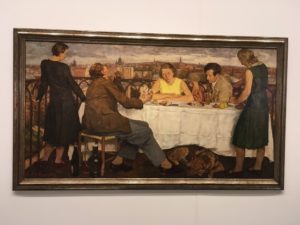
1930: Berliners concerned about the future (Neue Nationalgalerie)
Here is a summary (and to some degree a review) of the recent tour to Europe to Hamburg, Berlin, Vienna, Zurich and Lucerne, all wonderful cities purveying music and opera (and much else) at the highest standard. It was a very happy and companionable group; moving about, visiting museums and listening to music in these great cities was a constant privilege for us all.
Andrew Neill, prodigious music lover, writer on music and expert on Elgar and Strauss (president of the British Strauss Society to boot) has generously written and sent me a critique of most of the performances we attended so I have sprinkled this summary with many of his remarks, full of insights, and rather more critical that I have been. Thanks Andrew!
HAMBURG
On 11 June, twelve of us gathered in Hamburg at the Hotel Henri in the centre of the city, a short walk from the Elbe. We found the Henri added something special with its decor,, spacious rooms and friendly reception area where you could eat, drink or just lounge any time of the day or night, and help your self on an honour system to something to eat or drink. I should say no doubt Judy will hold different memories towards the Henri – bound to constant enquires and vigilance to locate her missing luggage.
In the evening Claudia took us to VLET restaurant with its view directly on to the river – a welcome dinner, almost at water level, where the food was delicious and we sampled copious amounts of Vlet Cuveè Rot and Vlet Grauburgunder before walking back to the Henri for a much needed sleep for those of us who had just arrived from Australia.
On Sunday morning, 12th, we set off with the sounds of Sunday morning bells ringing across the city for a walking tour of the inner part of the city in the excellent and humorous hands of our guide Jutta. The tour of the old Speicherstadt was fascinating with its grim warehouses and enclosed waterways, and moving to the modern residential district Hafen City, and finishing up at the amazing new Elbe Philharmonie, from the outside at least, looking like a ship about to embark down the river, maybe the most impressive new hall for classical music since the Sydney Opera House.
Speicherstadt, Hamburg
Our first performance that night, was at the Hamburg State Opera, rebuilt in the 1960s and in plain functional style from the traditional opera house destroyed during WW2. Mozart’s The Marriage of Figaro was a revival of Stefan Herheim’s controversial but also much praised production featuring a box-type set covered in every direction in Mozart’s musical scores. Costumes, movement and settings were essentially of the period of the opera’s creation, but the presentation was totally original, almost like a toy theatre. But this eccentric appearance in
no way compromised strong characterisation of all key parts. While none of us had seen a Figaro like this before, it removed itself from a traditional comedy of manners and strongly brought out the clashes and conflicts that often get smoothed over. The most striking element to me was the
Marriage of Figaro – end of first act
presence of most of the characters onstage most of the time. It resulted in everyone on stage knowing and responding to what was happening in real time. I found this both entertaining and revealing though some of us found this confusing. Some also found the orchestra ensemble not quite up to the mark – not me with my defective hearing – but the singing and characterisation were good except for a lumbering Cherubino completely out of character.
We met Jutta again on Monday morning for an audio guided boat trip down the Elbe, past the huge container wharf infrastructure on the south side and premium residential districts on the north. Her commentary was informative and so interesting to add to our knowledge and an easy way to learn more: cold and windy sailing down river but warming up coming back with the wind behind us.
With much anticipation we headed to the Elbe Philharmonie for our concert that night. We entered through the red original foundation up an endless curving escalator to the top of the new section with magnificent views of the city and the river in all directions from a balcony around the whole building. Then an endless successive flights of light timber coloured stairs that make walking up SOH stairs like a doddle in comparison. The main auditorium itself, again finished in light coloured wood is very impressive and has a fine acoustic. The program scheduled was rather uninteresting – disappointing that something more dynamic was not available. The main piece, Schoenberg’s Pelleas and Melisande seemed a heavy dreary work with little textural and rhythmic variation. The other pieces were popular orchestral show pieces as if it was for an audience strolling in the park.
As we emerged down the countless steps and never ending escalator, we thought it a spectacular but curiously user-unfriendly building.
Elbephilharmonie, Hamburg
BERLIN
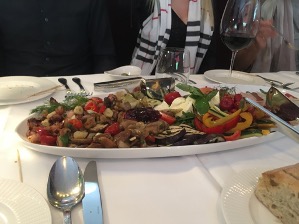 The train whisked us to Berlin on Tuesday 14th, then taxis to trendy Mitte district in Hackescher Markt, to the Camper Casa Hotel, our favourite hotel from past visits to Berlin: dynamic and functional room design, with a top floor to eat and drink on an honour system at any time of the day or night. On our first night, another personal favourite of mine was to revive ourselves with a taxi ride across Berlin for a first sighting of the Brandenburg Gate to dine at Nuovo Mario’s in Fasanenstrasse, a fabulous over-the-top Italian restaurant where the waiters greet you like long-lost friends, present you with giant plates of luxurious food and top up your wine so that before long you at all completely out of control until you are presented with a massive bill for your over-indulgence – a great business model!
The train whisked us to Berlin on Tuesday 14th, then taxis to trendy Mitte district in Hackescher Markt, to the Camper Casa Hotel, our favourite hotel from past visits to Berlin: dynamic and functional room design, with a top floor to eat and drink on an honour system at any time of the day or night. On our first night, another personal favourite of mine was to revive ourselves with a taxi ride across Berlin for a first sighting of the Brandenburg Gate to dine at Nuovo Mario’s in Fasanenstrasse, a fabulous over-the-top Italian restaurant where the waiters greet you like long-lost friends, present you with giant plates of luxurious food and top up your wine so that before long you at all completely out of control until you are presented with a massive bill for your over-indulgence – a great business model!
On Wednesday, the first full day in Berlin some went to the famed Jewish museum created by Daniel Libeskind, while others took advantage of the warm sunny weather to stroll elsewhere, then a light meal at the Tajikistan Tearoom where we struggled to sit cross-legged on a carpet and sip tea. Defeated by cramp, I gave up and joined the others sitting under a tree on actual chairs.
A big number that evening: Richard Strauss’s Elektra at the renovated Staatsoper Unter den Linden, a revival of the famed production from 2013 by Patrice Chereau, the director of the landmark Wagner Ring at Bayreuth in the 1980s. Andrew Neill had this to say about it:
‘This was fabulous – one of the greatest Elektra’s I have heard. Barenboim – who has back problems – was replaced by his protégé, Thomas Guggeis – well ‘watch this space’! This was fabulously sung with a Rolls Royce cast – René Pape as Orest and even the likes of Cheryl Studer and Roberta Alexander in minor rolls. Ricarda Merbeth was a ‘stupendous’ Elektra but, for me, the star of the evening was Vida Miknevičiûté as Chrysothemis – her voice soaring above Strauss’s orchestration – what a performance – what a masterpiece! Nothing more needs to said, except that the renowned Staatskapelle orchestra (Barenboim’s) lived up to its reputation.’
Beautiful sunshine to do probably far too much walking: however we set off from the Brandenburg Gate first to the monumental Holocaust Memorial, then through rather sparse looking Tiergarten and several more blocks to the Scandinavian embassies building housing all five countries’ diplomatic enclaves – a long walk in the hot sun, relieved by drinks in the embassy. Another long walk to the Neue Nationalgallerie showing a fascinating series of themed paintings and sculptures, highlighted by US artist Barbara Kruger’s massive floor based exhibition of text statements by leading 20th century writers. Most of us were glad to get back to Casa Camper for a rest whilst Sally and Vickie seemed endlessly energetic on their bikes.
For the evening it was off to the Deutsche Oper, largest of Berlin’s three full time opera companies situated in former West Berlin, to see a new production of Verdi’s Sicilian Vespers. A competent, if hardly inspired production by French. Director Olivier Py, the opera is long and full of action. Instead of the historical setting in 1292 at the time of the uprising of Sicilian rebels against the French occupation, this production was updated to the French occupation of Algeria in the 19th c. Composed after La Traviata, it was his first commission for the Paris Opera requiring big ballet scenes and spectacular action that this production failed to set alight. In the end it came down to the singing and interaction between the four main characters, the tyrannical French governor, Guy de Montfort, the hero and rebel Henri, his betrothed Helene and the leader of the rebels Jean Procida, all of them fine singers, especially leading baritone Michael Volle as Montfort. Verdi takes too long to resolve the basic conflict resulting from the French governor’s discovery that his long lost son is the hero of the rebels.
We substituted our scheduled walk in the Botanic gardens on Friday 17th for a free day of our choice except indefatigable Julia who was unfazed by a 45 minute train journey on a sunny day. She said it was a wonderful experience and I for one felt rather ashamed not to have made the effort.
In the evening we went to the famed Philharmonie, my all-time favourite concert hall, always chock-full of music loving Berliners milling around the vast ground floor foyer. Then when the soft deep bells calls us, everyone moves up the many staircases to the auditorium with its asymmetric banks of seats tilting in different directions. Roof of the Philharmonie, Berlin
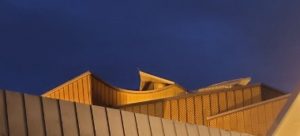 The concert was spectacular, first with Dutch violinist Janine Jansen playing the Sibelius concerto with slender ravishing tone at the beginning and later with passionate attack, altogether a marvellous performance I will never forget. Andrew commented: ‘the Berlin Philharmoniker under Sakari Oramo for the Sibelius concerto with Janine Jensen a superb soloist: those glorious lower orchestral strings giving her a glorious nut brown accompaniment. Her Bach encore (the largo from the violin sonata in c major – BWV 1005) had me near to tears.’
The concert was spectacular, first with Dutch violinist Janine Jansen playing the Sibelius concerto with slender ravishing tone at the beginning and later with passionate attack, altogether a marvellous performance I will never forget. Andrew commented: ‘the Berlin Philharmoniker under Sakari Oramo for the Sibelius concerto with Janine Jensen a superb soloist: those glorious lower orchestral strings giving her a glorious nut brown accompaniment. Her Bach encore (the largo from the violin sonata in c major – BWV 1005) had me near to tears.’
After the interval, we heard the extraordinary tour de force, the first symphony by the mid-teenage Langgaard, forgotten (until recently) early 20th century composer. His eccentric but accomplished use of the large orchestra and many extra brass players in the last movement gave an overwhelming sonic effect that had the audience on their feet at the end.
Saturday, our last day in Berlin, Wagner’s Meistersinger, his only comedy and longest opera. The production was by the well known opera production team (dramaturgy, design and direction) of Morabits, Wieler and Viebrock. Always noted for their serious analytical approach to their projects, it turned out to be serious indeed, though hardly in the way Wagner envisaged it. Set in what appears to be a modern academic school, maybe a music school, it avoids all references to Wagner’s concept of a 17th century Nuremberg, shows overt sexual behaviour between heroine Eva and her mentor Hans Sachs, seen here, not as a wise and world weary cobbler/ poet, but as a department head with dubious morals and behaviour. While Wagner no doubt would have been shocked with this cynical interpretation of Sachs, it was consistent with 20th century morals and self-seeking, especially at the end with Eva and Walther walking out of the celebrations and Sachs being tossed around and grinning like a sporting hero. Some of us were very disappointed with the curious updating. Again Andrew, who hated the production:
‘Each act was entirely enclosed – no sunshine was allowed in and there was no gathering in the open air at the end – so critical after the intensity of the quintet! Of course, there were some good ideas but these were swamped by the claustrophobic and at times very silly production. Johan Reuter was a good Sachs (despite being made to look like a fool) and Albert Pesendorfer was excellent as Pogner. The quintet in Act 3 lacked intensity with little interaction between the singers which I found surprising.’
The production was shorn of its inherent 19th century sentimentality and anti-semitism and maybe that’s a good thing, but it was not the Meistersinger we have grown to love. There is an interesting review in Bachtrack at https://bachtrack.com/review-meistersinger-morabito-wieler-viebrock-deutsche-oper-berlin-june-2022.
VIENNA Rear of St Stephens, Vienna
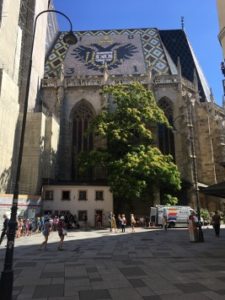 An all day relaxing train trip on Sunday 19th from Berlin to Vienna, – sensible because of the airport chaos and remarkably comfortable and painless. Great European cities both, but oh, so different. The raffish international metropolis of Berlin is another planet from elegant, timeless and stately Vienna, recently and deservedly recognised as the world’s most liveable city.
An all day relaxing train trip on Sunday 19th from Berlin to Vienna, – sensible because of the airport chaos and remarkably comfortable and painless. Great European cities both, but oh, so different. The raffish international metropolis of Berlin is another planet from elegant, timeless and stately Vienna, recently and deservedly recognised as the world’s most liveable city.
Our first night was magical – walking along the Graben, past the Albertina to the Burggarten and into the Palm House and back home again to our centrally placed Hotel Royale smack in the centre of Vienna and right behind St Stephens.
Following breakfast each day Claudia led us through the charm and delight of Viennese streets to her family restaurant to host our talks, one by myself, another by Andrew and another by Adam. Thank you for this Claudia. From there we would head off for various excursions: Monday, hot and cloudless, to the famous Schönbrunn palace and gardens outside the city. With Strauss’ delectable last opera Capriccio scheduled for the evening at Vienna State Opera, we came back to our Hotel Royale to rest before the performance. I thought the production, made famous by Renée Fleming in 2013, was gorgeous. Non-period specific, it was full of mirrors, glamorous colours and lighting. The orchestra had the music in its bones and the singers were generally excellent. As our Strauss authority, Andrew had this to say about it:
‘By 1940 Strauss knew he would not write more than one more opera and, so he, concocted his farewell to the stage as he would have wished – calmly, thoughtfully, ignoring the world beyond his front door and allowing his favourite instruments – the horn and soprano voice to have the last word. Actually, it is the orchestra which has this – Strauss the master orchestrator – which says it all – those tense but unobtrusive final chords bringing tears to the eyes and the curtain falling on an empty stage (or in the Staatsoper’s version an almost empty stage).I have had the privilege of hearing Felicity Lott, Kiri Te Kanawa, Renée Fleming and Miah Persson amongst others as Countess Madeleine. Maria Bengtsson (good as she was) did not dispel memories of these great interpreters of the role, but she has the right voice for the part, suggests the right amount of engagement and (importantly) detachment and, if the wonderfully ingenious set finally let the side down at the end, she was a Countess to remember. The set – well it was too large for the intimacy the final scene demands – leading from the so-called ‘moonlight’ music. It was all mirrors – not just one – adding too much to her soon forgotten struggle to come to terms with her dilemma – Prima la music e poi le parole. Otherwise, the set was brilliant – moving around as the cast and ideas changed – elegant and timeless.’
Tuesday 21st was gallery and museum day for most of us, first to the Secession Museum with its Beethoven Frieze by Gustav Klimt, then on to the Albertina Modern for a special exhibition of Klimt drawings, magnificent in their range and eloquence. The main special exhibition at the Albertina Modern was of all sorts of media by Ai Weiwei, a spectacular survey of his mostly political art works and installations. Sally together with Trudy and Adam happened upon a tour of the Musikverein which preceded a wander round the Belvedere Gardens.
In the evening it was again the incomparable Vienna Philharmonic, for a concert in the spacious Grosse Saal of the Konzerthaus, rather like the Concertgebouw Amsterdam in size and layout. All three successive performances we saw in Vienna featured the Vienna Philharmonic, two operas at the State Opera and this concert, probably different players in each case, not so hard when you know the orchestra has 200 players on its list, plays for all opera performances plus a full roster of concerts, recordings and tours abroad. A colourful trumpet concerto by Russian composer Weinberg, protege of Shostakovich and played by Swedish virtuoso Hakon Hardenberger, started the concert, followed by Shostakovich’s brief and mostly lyrical (except for the last movement) 9th symphony. After the interval the orchestra, conducted by Andris Nelsons, gave us a full bodied performance of Dvorak’s 6th symphony, thought by many to be a kind of homage to Brahms 2nd symphony. I know most of us found this concert uplifting and marvellous
Vienna Philharmonic conducted by Andris Nelsons at the Konzerthaus
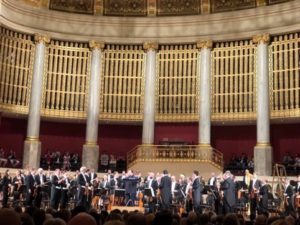 |
Wednesday 22nd our last day in Vienna: as usual full of great interest and we had two unusual and fascinating visits. A tram ride and walk first to the Kunst Haus established by the eccentric Austrian artist and promoter of art as an everyday ingredient in people’s lives, Hundertwasser, who not only created his own unique museum and village in Vienna, but moved all over the world creating and promoting his original idea of community art, with a special affection for New Zealand. Then the Sigmund Freud museum, full of art, artefacts, memorabilia and photos of his life and work. I have to say I found it obscure and gave a casual observer like me little insight into his original genius though Sally found the experience particularly moving of seeing at first hand the reality of 18 Jewish families being required to move and live in the same space.
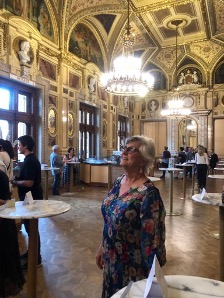 In the evening, The Magic Flute at the Wiener Staatsoper seemed to me a rather tired production with an inadequate Queen of the Night and Tamino though neatly conducted by baroque specialist Ivor Bolton. I agreed with Andrew and Michael that I’m “over” the pantomime of this opera’s performances, despite the wonderful music. It is enough for me in future to listen to one or other of the many great recordings made of it. Before he left to return to London, Andrew commented: ‘We heard our second Mozart opera of our tour – by that prodigious genius who topped and tailed our trip. We have heard operas from the greatest four composers who wrote for the stage post Handel (with apologies to Ludwig van) and I say this with the greatest respect to Rossini, Donizetti, Puccini, Janáček and Britten. It is, of course, the music in the Magic Flute that matters – the story is hardly relevant as Mozart pours his brilliance into a score with multiple meanings and implications. It has music of joy, humour and the greatest profundity and one has the right to expect that the conductor, performers, and producers all respect, to a degree, these aspects. Alas we were largely disappointed. The best was the orchestra with Ivor Bolton’s vivid conducting pointing up Mozart’s glorious orchestration and the changing colour and rhythms.’ Judy at Vienna State Opera
In the evening, The Magic Flute at the Wiener Staatsoper seemed to me a rather tired production with an inadequate Queen of the Night and Tamino though neatly conducted by baroque specialist Ivor Bolton. I agreed with Andrew and Michael that I’m “over” the pantomime of this opera’s performances, despite the wonderful music. It is enough for me in future to listen to one or other of the many great recordings made of it. Before he left to return to London, Andrew commented: ‘We heard our second Mozart opera of our tour – by that prodigious genius who topped and tailed our trip. We have heard operas from the greatest four composers who wrote for the stage post Handel (with apologies to Ludwig van) and I say this with the greatest respect to Rossini, Donizetti, Puccini, Janáček and Britten. It is, of course, the music in the Magic Flute that matters – the story is hardly relevant as Mozart pours his brilliance into a score with multiple meanings and implications. It has music of joy, humour and the greatest profundity and one has the right to expect that the conductor, performers, and producers all respect, to a degree, these aspects. Alas we were largely disappointed. The best was the orchestra with Ivor Bolton’s vivid conducting pointing up Mozart’s glorious orchestration and the changing colour and rhythms.’ Judy at Vienna State Opera
On Thursday 23rd, our last day in Vienna, we were driven by coach out through the Vienna Woods, walked in a wonderful garden at Baden, full of roses and several exotic landscape photographic exhibitions, and finished up in the delightful old wine village of Gumpoldskirchen. We dined outdoors at a tavern Spätrot, drank more Grüner veitliner and met Claudia’s husband Michael and his father Walther. Our last night with Andrew and Vickie and we drank his health for his birthday and he was duly congratulated. He and Vickie departed nextmorning to return home to London while the rest of us boarded a flight to Zurich.
ZÜRICH
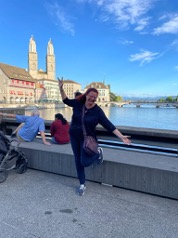 On arrival, a brisk turn around to check in and be off to the Opera House for a performance of the Zurich Ballet for Ibsen’s Peer Gynt with orchestral accompaniment of Grieg’s music for Peer Gynt and other of his gems including the Lyric Suite, String Quartet and the A minor piano concerto. With amazing costumes for the trolls and superb choreography to support the narrative of Peer’s crazy bucolic journey through a fantasy landscape, it was a memorable dance experience for the audience, wildly applauded at the end which happened to be the last performance of the season and with season-end presentations to many of the cast by the choreographer Edward Klug.
On arrival, a brisk turn around to check in and be off to the Opera House for a performance of the Zurich Ballet for Ibsen’s Peer Gynt with orchestral accompaniment of Grieg’s music for Peer Gynt and other of his gems including the Lyric Suite, String Quartet and the A minor piano concerto. With amazing costumes for the trolls and superb choreography to support the narrative of Peer’s crazy bucolic journey through a fantasy landscape, it was a memorable dance experience for the audience, wildly applauded at the end which happened to be the last performance of the season and with season-end presentations to many of the cast by the choreographer Edward Klug.
The next day Saturday 25th, a warm summer day, we were taken on a most interesting guided walk through the old city, full of elegant buildings, smart shops and beautiful churches. A highlight was the visit to the majestic Fraumünster church for the remarkable and colourful windows by Chagall. A free afternoon for our own wanderings and then a superb dinner beside the river under trees La Terrasse.
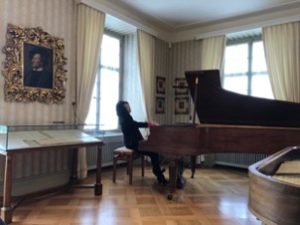 Sunday 26th our final tour day and a true culmination with a revival of a much admired 2013 production by famous German director Claus Guth of Wagner’s epic Tristan and Isolde.The production is famous for the setting, not as Wagner wrote it on sailing ship journeys between mediaeval Ireland, Cornwall and Brittany, but within the Zurich villa of his patron of the time he wrote the opera, Otto Wesendonck and his wife Mathilde with whom Wagner was in love. The concept, confusing in some respects such as the apparently alter ego between Isolde and Brangäne, was nevertheless illuminating and convincing. The performance, conducted by Gianandrea Noseda, (though I felt the orchestra was too loud in the fairly small theatre), was well sung and especially by Camilla Nylund as Isolde. Most of us seemed to think the worst aspect was the very long table that dominated the stage in the 2nd and 3rd Acts upon which a rotund portly Tristan and Isolde climbed on to several times for clumsy and almost ridiculous love-making.
Sunday 26th our final tour day and a true culmination with a revival of a much admired 2013 production by famous German director Claus Guth of Wagner’s epic Tristan and Isolde.The production is famous for the setting, not as Wagner wrote it on sailing ship journeys between mediaeval Ireland, Cornwall and Brittany, but within the Zurich villa of his patron of the time he wrote the opera, Otto Wesendonck and his wife Mathilde with whom Wagner was in love. The concept, confusing in some respects such as the apparently alter ego between Isolde and Brangäne, was nevertheless illuminating and convincing. The performance, conducted by Gianandrea Noseda, (though I felt the orchestra was too loud in the fairly small theatre), was well sung and especially by Camilla Nylund as Isolde. Most of us seemed to think the worst aspect was the very long table that dominated the stage in the 2nd and 3rd Acts upon which a rotund portly Tristan and Isolde climbed on to several times for clumsy and almost ridiculous love-making.
After the Tristan performance we celebrated and farewelled each other eating delicious traditional food for our farewell dinner. There were farewell speeches and hugs for Jennifer Fraser and Judy Chapman – Jennifer for Milan, and Judy to Budapest who left us the following morning whilst the rest of us continued for a few days in Lucerne.
The long table for the lovers in Tristan and Isolde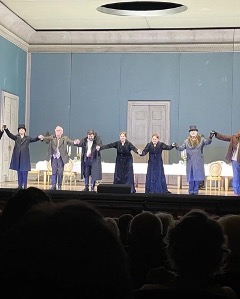
LUCERNE
Another train the next day to Lucerne where our Hotel was not quite ready for us – Hotel des Alpes – on the river that leads a few hundred metres away to Lake Lucerne (strangely referred to by locals as Vierwaldstättersee). Each morning we had breakfast beside the river and the fabulous market bridge, with stupendous views of the surrounding craggy mountains, often obscured by threatening clouds. It’s a lovely compact city and the next morning, Tuesday 28th, we set off across the bridge, to walk to Wagner’s summer house – passed the splendid concert hall, very steel and girders, designed by Jean Nouvel (Paris Philharmonie, Sydney Central Park) and through the woods to the famous Villa Tribschen, Richard Wagner’s sometime home on the shore of the lake and now a major repository of his scores, memorabilia, paintings and perhaps most important of all, his Erard piano on which he tested his ground-breaking harmonies as he composed. The Director, Dr Mueller, gave his exclusive time and expertise, answering questions and giving explanations. Best of all, we were honoured with a recital arranged just for us played on the Erard piano by brilliant young Taiwanese pianist Shih Wei Huang. She played Chopin’s Fantaisie Impromptu in C sharp minor and Liszt’s Rigoletto Paraphrase more memorably than I have ever heard them, no doubt partly due to being played on a piano made at a time when they were composed and when Wagner was also composing his mature operas. The velvety sound she produced on the piano was uncannily reminiscent of Wagnerian harmony. In the evening with clouds threatening some of us ate at a craft beer bar-restaurant on the river front near our hotel to drink delicious beers and eat hamburgers.
On Wednesday, our last day in Lucerne, we enjoyed an excursion that was as close to paradise as you could imagine. Beautifully organised by Claudia and like magic, the weather cleared for our crowded tourist boat, to take us for an hour across and around the lake, surrounded by amazing mountains with colourful villages along the shore line to the small town of Vitznau. Here we travelled up a steep, steep cog railway to Mt Rigi, 1800 metres high. From there a walk down the steep track beside the cog rail with breath-taking views in every direction of the lake, mountains,
Mt Rigi overlooking Lake Lucerne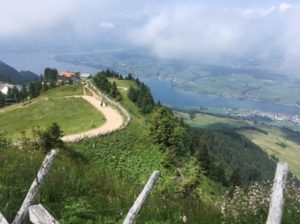
precipitous drops snd profusions of wild flowers in full bloom, back to the cable car which swung us down to the village of Weggis on the lake shore and then the boat back to Lucerne. What a way to finish our tour! All that was left was dinner on a terrace overlooking the river as the sun slowly set and heartfelt farewells to everyone.
Claudia’s flight cancelled and unable to fly to Vienna had to find an alternative route to Vienna so took an 11 hour train trip to return her home. Inese with a 12 hour layover enroute and Judy and Jennifer in overwhelming heat. Sally and I on the other hand in Munich a few days later on our last night in Europe attended a new production of Berlioz’s massive masterpiece, The Trojans, a 5 hour opera never performed in his lifetime, partly because the French turned their face against his genius and partly because its stage and musical demands are so huge. Never having seen it on stage, though knowing the music well, I felt it was a must to see it. While sung and played well, the experience was bitterly disappointing as the production was not only terrible, but obscene and absurd, an unbelievable example of directorial self indulgence. Worst of all, the program stated it was a co-production between the Bavarian State Opera and Opera Australia (Brisbane). I will tell OA they should forget it. Here is the headline from a review we found: ‘Desperately mediocre evening of blood and porn’.https://www.ft.com/content/e91fc0e3-1681-449f-af1d-bca87a5d2995
I know all of us have different slants but in the years to come as you re-read this I hope it will jog your memories of our time together and the music we heard and experiences we shared. We plan an Austrian summer festival tour in late August 2023: Salzburg, Schwarzenberg and Innsbruck – wonderful festival music – not much travel but great listening. So put that in your diaries.
Best wishes to everyone
Antony Jeffrey – 13 July 2022

